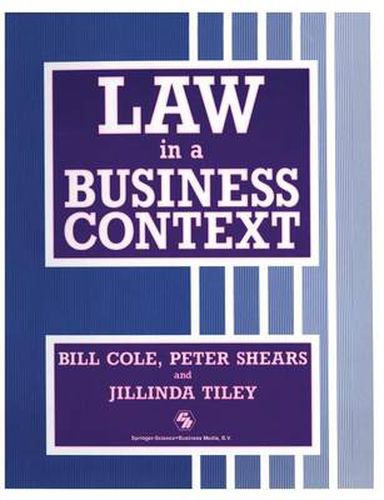Readings Newsletter
Become a Readings Member to make your shopping experience even easier.
Sign in or sign up for free!
You’re not far away from qualifying for FREE standard shipping within Australia
You’ve qualified for FREE standard shipping within Australia
The cart is loading…






This title is printed to order. This book may have been self-published. If so, we cannot guarantee the quality of the content. In the main most books will have gone through the editing process however some may not. We therefore suggest that you be aware of this before ordering this book. If in doubt check either the author or publisher’s details as we are unable to accept any returns unless they are faulty. Please contact us if you have any questions.
This book aims to demonstrate that legal complaints form the background for making business decisions and in the text legal principles are grouped according to their relevance to business. After surveying the sources of law, the court system and out of court settlements (where most legal disputes are resolved), the authors discuss the legal forms which a business can take, employment legislation, health and safety regulations, the sale of goods, product liability, constraints on advertising and insurance. Certain topics for example ways of protecting innovative ideas (patents, trademarks, designs), are discussed in more detail than is usual at this level. The role of trade and consumer associations, the Data Protection Act 1984 and the supply of credit are among other subjects examined. At the end of each chapter there are suggestions for further reading. and these references include not only academic texts, cases and statutes, but practical (and sometimes free) guides issued by, for example, trade associations, government departments, banks and the Equal Opportunities Commission. Case studies have been given in all chapters to illustrate the themes under discussion, sometimes with the addition of contemporary newspaper cuttings. Questions for discussion and problems for further consideration are given at the end of each chapter. Written for students following courses in business and management at degree level or equivalent, it will also be useful to students on BTEC Higher courses, post-experience or post-graduate management courses and professional courses in, for example, accountancy or marketing. This book is one of six titles in the Business in Context series which aims to provide business-centred, rather than discipline centred, coverage of the main subjects currently associated with a wide range of business studies programmes.
$9.00 standard shipping within Australia
FREE standard shipping within Australia for orders over $100.00
Express & International shipping calculated at checkout
This title is printed to order. This book may have been self-published. If so, we cannot guarantee the quality of the content. In the main most books will have gone through the editing process however some may not. We therefore suggest that you be aware of this before ordering this book. If in doubt check either the author or publisher’s details as we are unable to accept any returns unless they are faulty. Please contact us if you have any questions.
This book aims to demonstrate that legal complaints form the background for making business decisions and in the text legal principles are grouped according to their relevance to business. After surveying the sources of law, the court system and out of court settlements (where most legal disputes are resolved), the authors discuss the legal forms which a business can take, employment legislation, health and safety regulations, the sale of goods, product liability, constraints on advertising and insurance. Certain topics for example ways of protecting innovative ideas (patents, trademarks, designs), are discussed in more detail than is usual at this level. The role of trade and consumer associations, the Data Protection Act 1984 and the supply of credit are among other subjects examined. At the end of each chapter there are suggestions for further reading. and these references include not only academic texts, cases and statutes, but practical (and sometimes free) guides issued by, for example, trade associations, government departments, banks and the Equal Opportunities Commission. Case studies have been given in all chapters to illustrate the themes under discussion, sometimes with the addition of contemporary newspaper cuttings. Questions for discussion and problems for further consideration are given at the end of each chapter. Written for students following courses in business and management at degree level or equivalent, it will also be useful to students on BTEC Higher courses, post-experience or post-graduate management courses and professional courses in, for example, accountancy or marketing. This book is one of six titles in the Business in Context series which aims to provide business-centred, rather than discipline centred, coverage of the main subjects currently associated with a wide range of business studies programmes.